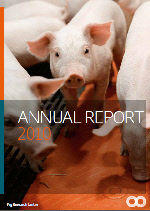



Danish Pig Research Centre: Annual Report 2010: AI Research & Development
Activities within AI research and development in Denmark in 2010 is outlined in the latest annual report from the Danish Pig Research Centre.
Research and Development
All activities within AI research and development are co-financed by DanBred's AI stations. All projects are rooted in Pig Research Centre (PRC) and the AI stations through a joint management group that prioritises the projects.
Sale of Semen
Sale of semen from DanBred’s AI stations increased by 3.5 per cent compared with 2008/2009 corresponding to approximately 95 per cent of all matings being performed with semen purchased from an AI station. The basis of these figures is an estimated gilt and sow population of 1,082,000 in Denmark. The sale of semen in the last five years is shown in Figure 1.

Sexing of semen

A new method for sexing of boar semen is the outcome of a joint venture with the Welsh company, Ovasort Ltd. With this method, antibodies are used to bind sperm, i.e. sperm of one gender is bound to antibodies. It is thereby possible to separate sperm of different genders. At the end of 2010, PRC initiated a series of studies to investigate if it is practically possible to shift the balance between male and female piglets. If so, a commercial product that is easy and cheap to use at the AI stations on a daily basis will be developed. However, it must be emphasised that there is still a long way to go before this becomes a reality.
Defect sperm
It is a well-known fact that fertility of sperm depends on the percentage of defect sperm in a dose (Report 0711). PRC is currently developing an instrument for recording of sperm defects (Figure 2). The instrument will quickly and objectively record the percentage of defect sperm in a dose. It is expected to be able to analyse the capability of the instrument in the beginning of 2011.
Proteins in boar semen
Sperm consists of sperm and seminal plasma. Seminal plasma contains a variety of different substances believed to affect fertility. However, it has never been established which substances in semen affect fertility. PRC and the Swedish University of Agricultural Sciences (SLU) are currently co-operating on detecting substances that increase sperm fertility. Previous investigations demonstrated that the level of prostaglandin increased in the blood of the sow during insemination when diluted semen was used. Such an increase was not observed when raw semen was used for insemination. This increase in prostaglandin at insemination is undesirable.
The aim of the project with SLU is to detect the substance in sperm that inhibits the release of prostaglandin in the sow during insemination. When found, it will be possible to add this substance to sperm doses and thereby prevent increases in prostaglandin.
Quality control of L and Y sperm
Today, the shelf-life of boar semen is routinely analysed by subjective evaluation of sperm motility. Sperm motility is analysed three days after collection using a microscope. This method very much depends on the person using the microscope.
Together with the Danish AI stations, PRC is now implementing quality control procedures in which sperm motility of all Landrace and Large White boars will be analysed with the SpermVision CASA System. The system records a series of images of the sperm in a microscope, and sperm motility is analysed on the basis of these images. Thereby the shelf-life of sperm will be evaluated identically every single time, and it will be possible to rank boars according to sperm motility and, in the long run, reject boars on the basis of their rank. The new method will lead to a better sperm quality in general for Landrace and Large White in the future, and will hopefully contribute to reducing boar variance.
Reducing boar variance
Boar variance is the influence of the boar on litter size. Ideally, sperm ought not affect litter sizes if, that is, boars were unable to have reduced sperm quality. It has turned out that Large White boars are more often found to have reduced sperm quality than Landrace boars. Consequently, boar influence on litter sizes is greater than normal. This affects breeding adversely as the sow is ‘punished’ in index even though a low litter size may be attributed to a boar with reduced sperm quality.
In an attempt to reduce boar variance, sperm age is recorded in breeding and multiplier herds. With these recordings, it will be possible to trace a mating back to a certain semen collection.
Recent analyses indicate that boar variance is lower when sperm is used on day 2 instead of day 3. It is not surprising that fresh semen is more fertile but the benefit from fresh semen is probably greater if the boar is already suffering from reduced fertility. It is not yet clear whether part of the problems with reduced sperm quality for Large White is actually attributed to reduced shelf-life of the sperm.
Stimulation at service
A study demonstrated that it is not necessary to sit on, and thereby stimulate, the sow during insemination. However, it is essential to undertake a thorough oestrus detection that lasts approximately one minute. The study revealed that around three to five minutes can be saved per sow compared with previous recommendations according to which you had to sit on the sow during insemination.
* FIVE-POINT PLAN
|
The study was performed on four Danish production farms. All sows were subject to oestrus detection for approximately one minute according to the five-point plan.
The sows were subsequently inseminated; the semen doses for the trial sows were suspended above the sow with a clothes-peg. It is important to ensure that the catheter is inserted correctly in the sow; when the inseminator does not sit on the sow, it is not noted if the semen backflows.
Quality control of AI stations
PRC routinely make unannounced audits of the Danish AI stations. These unannounced audits are described in the joint guidelines for AI stations. PRC routinely analyses semen doses with the self-audit programme used by the AI stations. The aim of the self-audit programme is to routinely check number of sperm per dose, whereas the unannounced audits ensure that the AI stations do not violate the guidelines when it comes to sperm per dose.

In September 2009, unannounced audits were made of Hatting AI departments in Horsens, Aalborg and Viborg. In Aalborg and Viborg, the rules were met for sperm content per dose. One semen dose from Horsens contained fewer motile sperm cells than the target.
In December 2009, unannounced audits were made of Hatting AI departments Horsens, Ringsted, Viborg and Odense, Vestsjælland boar station and boar stations Mors 1 and 2. Results showed that all stations complied with the guidelines for sperm content.
Further Reading
| |
- | Go to our previous article on this report by clicking here. |
September 2011






